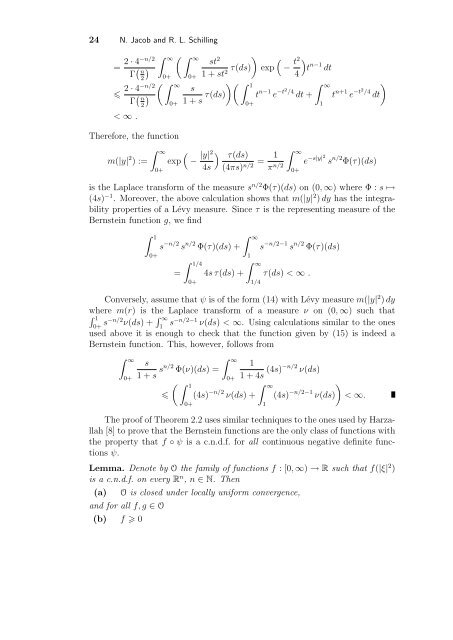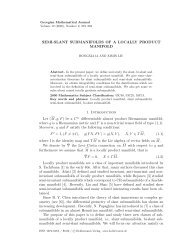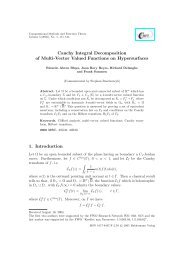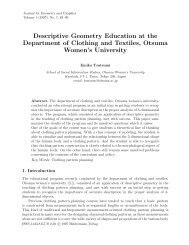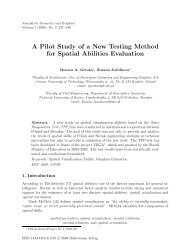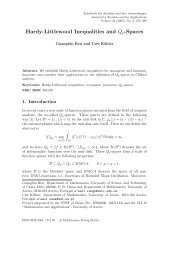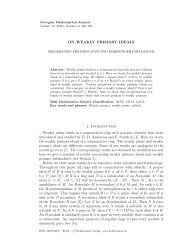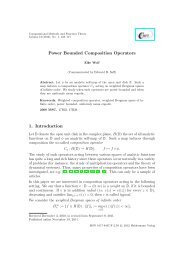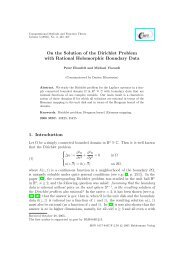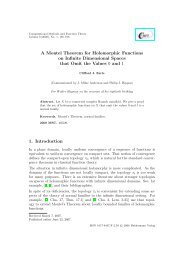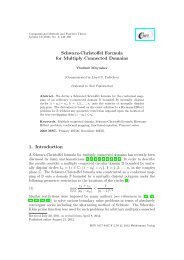Function Spaces as Dirichlet Spaces (About a Paper by Maz'ya and ...
Function Spaces as Dirichlet Spaces (About a Paper by Maz'ya and ...
Function Spaces as Dirichlet Spaces (About a Paper by Maz'ya and ...
Create successful ePaper yourself
Turn your PDF publications into a flip-book with our unique Google optimized e-Paper software.
24 N. Jacob <strong>and</strong> R. L. Schilling<br />
= 2 · ∫ ∞<br />
( ∫ ∞<br />
4−n/2<br />
Γ ( )<br />
n<br />
2 0+ 0+<br />
2 · ( ∫ ∞<br />
4−n/2<br />
Γ ( )<br />
n<br />
2 0+<br />
< ∞ .<br />
Therefore, the function<br />
m(|y| 2 ) :=<br />
∫ ∞<br />
0+<br />
exp<br />
)<br />
st 2<br />
( )<br />
1 + st τ(ds) exp − t2 t n−1 dt<br />
2 4<br />
)( ∫<br />
s<br />
1<br />
1 + s τ(ds)<br />
0+<br />
t n−1 e −t2 /4 dt +<br />
( )<br />
− |y|2 τ(ds)<br />
4s (4πs) = 1 ∫ ∞<br />
n/2 π n/2<br />
0+<br />
∫ ∞<br />
1<br />
)<br />
t n+1 e −t2 /4 dt<br />
e −s|y|2 s n/2 Φ(τ)(ds)<br />
is the Laplace transform of the me<strong>as</strong>ure s n/2 Φ(τ)(ds) on (0, ∞) where Φ : s ↦→<br />
(4s) −1 . Moreover, the above calculation shows that m(|y| 2 ) dy h<strong>as</strong> the integrability<br />
properties of a Lévy me<strong>as</strong>ure. Since τ is the representing me<strong>as</strong>ure of the<br />
Bernstein function g, we find<br />
∫ 1<br />
0+<br />
s −n/2 s n/2 Φ(τ)(ds) +<br />
=<br />
∫ 1/4<br />
0+<br />
4s τ(ds) +<br />
∫ ∞<br />
1<br />
∫ ∞<br />
1/4<br />
s −n/2−1 s n/2 Φ(τ)(ds)<br />
τ(ds) < ∞ .<br />
Conversely, <strong>as</strong>sume that ψ is of the form (14) with Lévy me<strong>as</strong>ure m(|y| 2 ) dy<br />
where<br />
∫<br />
m(r) is the Laplace transform of a me<strong>as</strong>ure ν on (0, ∞) such that<br />
1<br />
0+ s−n/2 ν(ds) + ∫ ∞<br />
s −n/2−1 ν(ds) < ∞. Using calculations similar to the ones<br />
1<br />
used above it is enough to check that the function given <strong>by</strong> (15) is indeed a<br />
Bernstein function. This, however, follows from<br />
∫ ∞<br />
0+<br />
∫ ∞<br />
s<br />
1<br />
1 + s sn/2 Φ(ν)(ds) =<br />
0+ 1 + 4s (4s)−n/2 ν(ds)<br />
( ∫ 1<br />
∫ ∞<br />
)<br />
(4s) −n/2 ν(ds) + (4s) −n/2−1 ν(ds) < ∞.<br />
0+<br />
1<br />
The proof of Theorem 2.2 uses similar techniques to the ones used <strong>by</strong> Harzallah<br />
[8] to prove that the Bernstein functions are the only cl<strong>as</strong>s of functions with<br />
the property that f ◦ ψ is a c.n.d.f. for all continuous negative definite functions<br />
ψ.<br />
Lemma. Denote <strong>by</strong> O the family of functions f : [0, ∞) → R such that f(|ξ| 2 )<br />
is a c.n.d.f. on every R n , n ∈ N. Then<br />
(a)<br />
O is closed under locally uniform convergence,<br />
<strong>and</strong> for all f, g ∈ O<br />
(b) f 0


